Patreon MUSICARTA Premium
Pyramids Variations - Lesson Two
Adding Left-hand-over Patterns
Looking at the Pyramids chord sequence, we can see two places where there are two bars on the same chord.

They are bars 7 and 8, on the E major chord, and bars 15 and 16, on A minor.
In these two places, instead of just playing the six basic music-making position (BMP) notes from bottom to top twice, we can use a more interesting twelve-note pattern called the ‘left-hand-over pattern’.
We are going to learn the left-hand-over pattern in our home chord of A minor. In the lesson performance, we showcase it in an added Introduction.
Here is your lesson performance.
The left-hand-over pattern
This is what two ordinary bars of A minor BMP notes look like in written-out music.
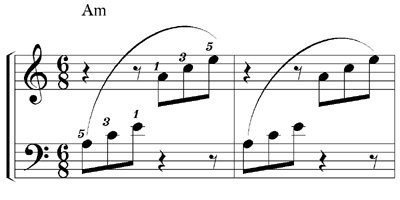
In the left-hand-over pattern (which lasts the same amount of time) the left hand passes over the right hand to play just one note, and then you play back down again.
Here’s what that looks like in written music.
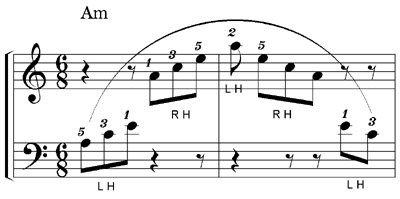
Here’s an illustration showing how to find the left-hand-over note in A minor.
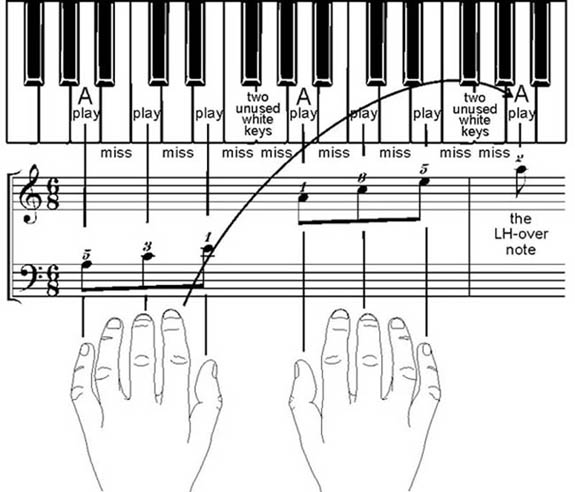
The left hand goes over the right hand to play the next ‘A’ going up the keyboard, then you play the notes back down again to fill up the bar.
In popular music, chords are our first priority. Along with the Basic Music-making Position, the LH-over pattern is one of the many useful chord shapes you will learn in the Pyramids Variations material.
The left-hand-over pattern introduction
We are going to play two LH-over patterns in A minor as an added-on Introduction to our improved Pyramids Variations performance.
Here is the Introduction written out, with instructions following:

Read this ‘walk-through’ to make sure you understand LH-over patterns.
- First play the six A minor BMP notes from the bottom (LH5) to the top (RH5). This fills the first bar.
- For the first note of the next bar, bring the left hand over, leave two unused white keys and play the next ‘A’ key up.
- To fill the second bar, play downwards from the top RH note (RH5), just five of the regular A-minor BMP notes. Because the left-hand-over note takes up a note’s space in the second bar, the LH-over pattern ends on the middle left hand note.
Remember to leave two unused white keys on the way down when you’re looking for where to put your left hand thumb.
Practice the pattern over and over. Notice any difficulties you have. Try to work out what your difficulty is and if any of the instructions or illustrations here can help you with it.
The left-hand-over pattern in E major
For bars 7 and 8, we need a LH-over pattern in E major. It’s just the same ‘shape’ as the A-minor patterns above.
First play the six-note E major BMP pattern a few times to remind yourself of the notes to use. The middle finger of each hand (finger 3) plays the black key G sharp.
Here is a keyboard diagram showing the keys we use.

Here is what the LH-over pattern in E major looks like in written-out music.
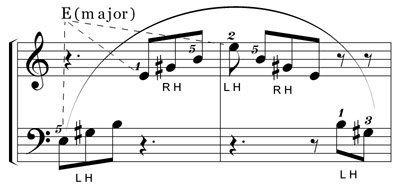
Follow the same instructions as before to play the LH-over pattern in E major.
- Play the six E major BMP notes going up.
- Bring your left hand over to play the LH-over note ‘E’.
- Play five BMP notes downwards to fill the bar, leaving two unused white keys between your thumbs and finishing on the left hand G sharp.
Here's a video to help you practice the LH-over pattern in E.
A left-hand-over ending
To finish, we want an A minor ending in bars 15 and 16 that uses the LH-over pattern. But if we play a full LH-over pattern, the last note will be C, the middle left hand note.

This is not a satisfactory ending. Note ‘A’ is a better note to end on.
There are two possible A’s we could finish on in the A minor LH-over pattern. The first is the LH-over ‘A’ at the top of the pattern:
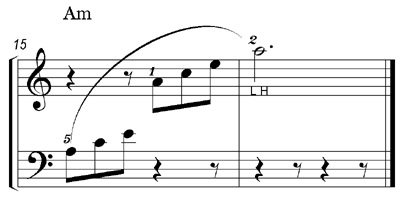
The other ‘A’ we could finish on is the RH thumb note, halfway back down the LH-over pattern:
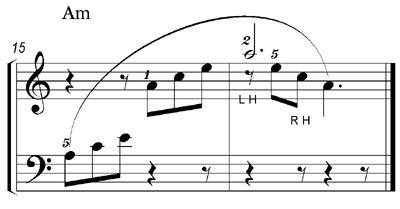
Try both of these endings. Neither of them is a full 12-note LH-over pattern.
The LH-over performance chord chart
The new Pyramids performance uses the LH-over pattern in A minor, played twice, as an introduction. Here is the new chord chart.
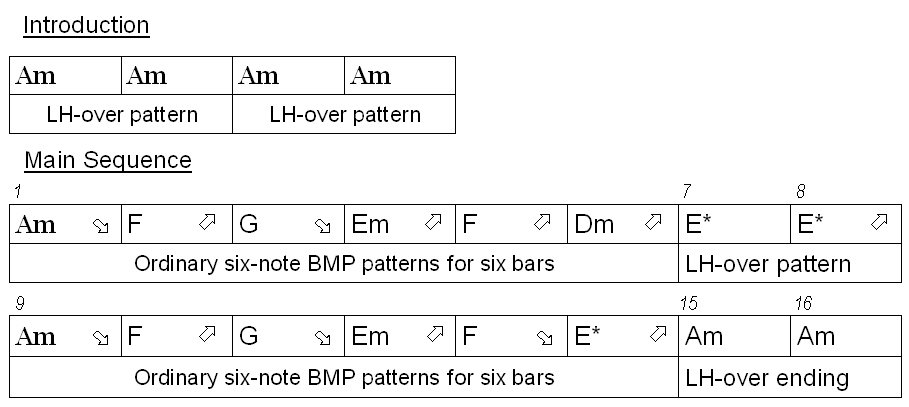
Here is the lesson performance again, with the parts subtitled.
Listen to the lesson performance audio and see if you can follow in the chord chart. (Give yourself a few goes if at first you don't succeed...)
A performance walk-through
Here is a ‘walk-through’ of the Pyramids with LH-over
Patterns performance. As you read it, find the part of the chord sequence that
is being described in the chord chart above and the Pyramids with LH-over
Patterns music in your workbook.
- You play an introduction of two full A minor LH-over patterns. Remember that the last note of the Introduction is a C (left hand, middle finger).
- Then you play six-note BMP patterns for six bars as shown in the chord sequence chart (exactly as for the first lesson performance) until you get to the two bars of E major at the end of the first half.
- For bars 7 and 8, you play one LH-over pattern in E major (black note – G sharp). (Remember that the last note of this pattern is G sharp, the middle finger of the left hand.)
- Go back to playing six-note BMP patterns for six bars starting bar 9 as shown in the chord sequence chart.
- For the last two bars you play the A minor LH-over ending you have chosen from the two alternatives given.
Work through the performance walk-through video.
Here are two more virtual keyboard/scrolling music videos, also with
commentary. You will find a reliable 'aerial view' of the performance
helpful in achieving a smooth performance.
Your performance
Here's the MS for the LH-over Patterns performance.
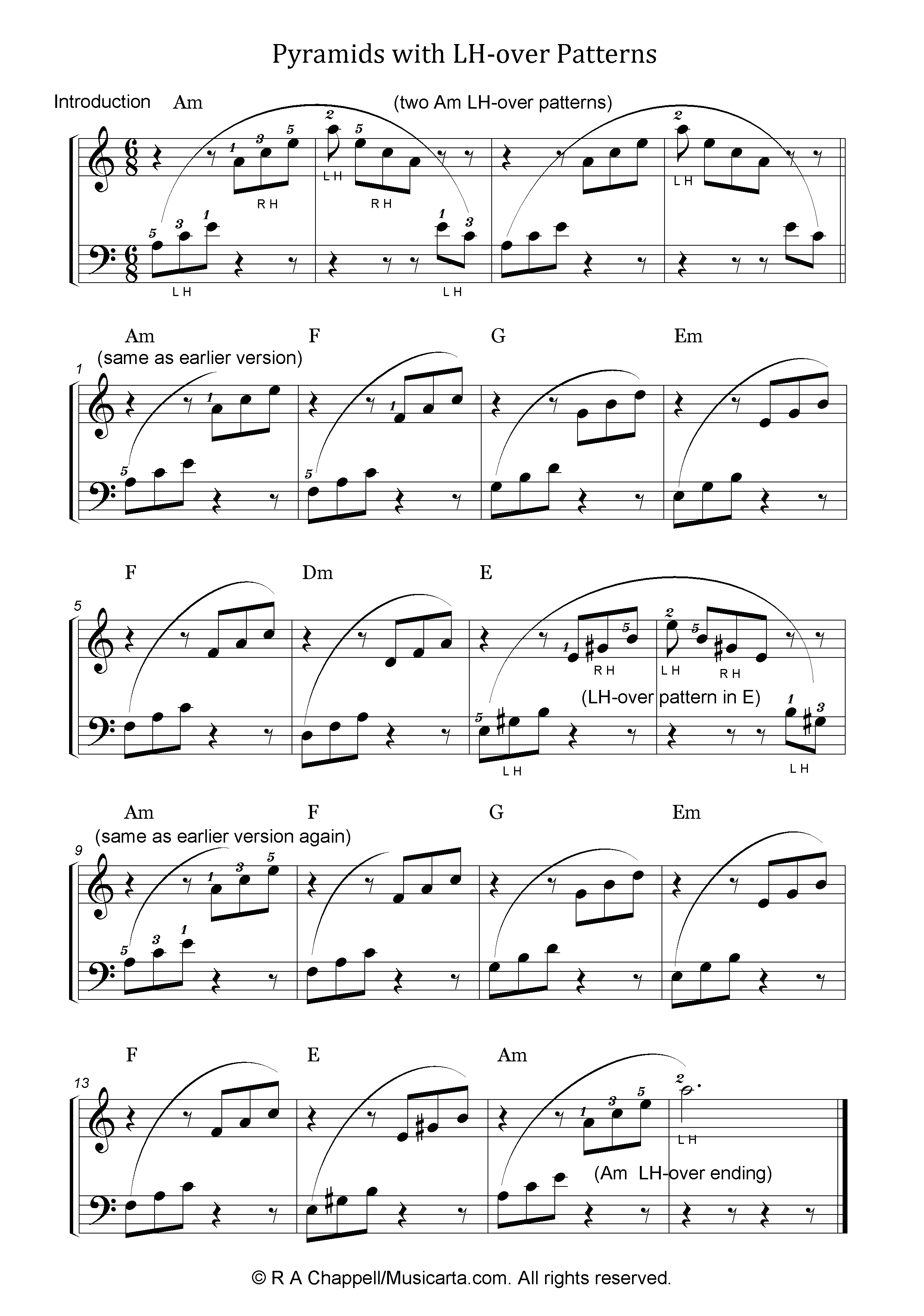
Only three small parts are different to the Lesson One performance: the Introduction, the LH-over pattern in E and the LH-over ending in A minor.
Don't worry if the music you're playing isn't exactly the same as in the audio clips and videos. Use the combined Basic Music-making Position and left-hand-over patterns as a springboard to your own compositions. Remember that ‘getting lost is the music’ is part of the plan!
Now go on to Lesson Three.
PATREON
|
The MusicartaA methodical approach to keyboard syncopation for
|
PUBLICATIONS
exciting keyboard
creativity courses
CHORDS 101
WORKBOOK

~HANON~
video course

Musicarta
Patreon
PENTATONICS
WORKBOOK
video course

Creative Keyboard
video course

BEAT AND RHYTHM
WORKBOOK

- Volume 1 -

12-BAR PIANO
STYLES WORKBOOK

MUSICARTA MODES
WORKBOOK

PIANO STYLE

CANON PROJECT
video course

VARIATIONS
video course


- Piano Solo -
video course

- Piano Solo -


YouTube playlists





 THE LOGO
THE LOGO
